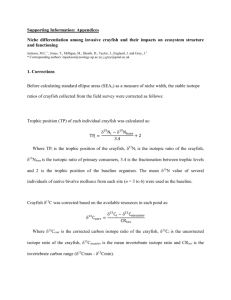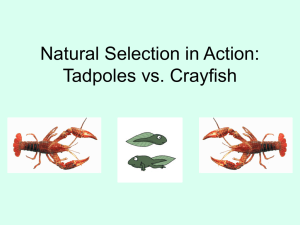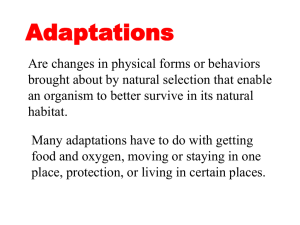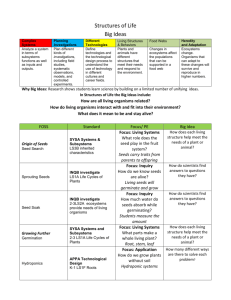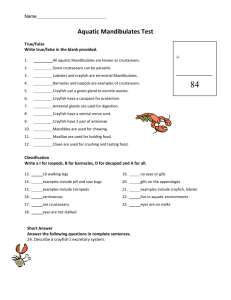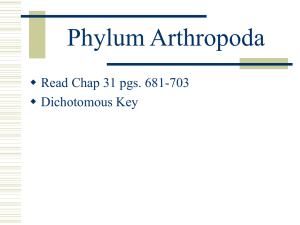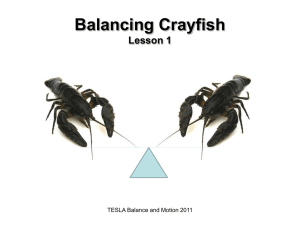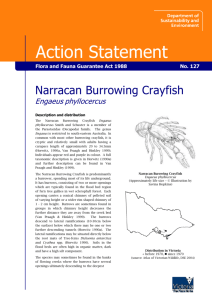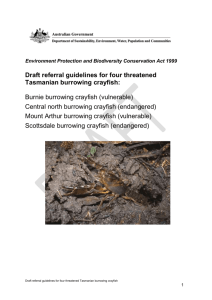Chapter 2 Assessment of Australia`s Terrestrial Biodiversity 2008
advertisement
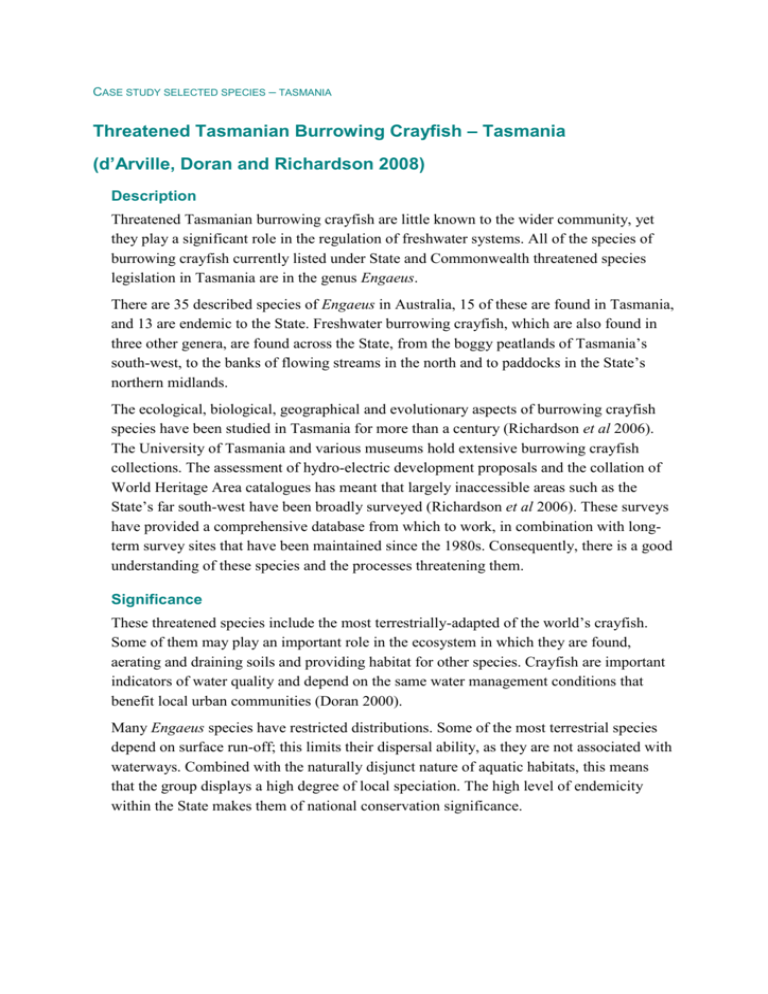
CASE STUDY SELECTED SPECIES – TASMANIA Threatened Tasmanian Burrowing Crayfish – Tasmania (d’Arville, Doran and Richardson 2008) Description Threatened Tasmanian burrowing crayfish are little known to the wider community, yet they play a significant role in the regulation of freshwater systems. All of the species of burrowing crayfish currently listed under State and Commonwealth threatened species legislation in Tasmania are in the genus Engaeus. There are 35 described species of Engaeus in Australia, 15 of these are found in Tasmania, and 13 are endemic to the State. Freshwater burrowing crayfish, which are also found in three other genera, are found across the State, from the boggy peatlands of Tasmania’s south-west, to the banks of flowing streams in the north and to paddocks in the State’s northern midlands. The ecological, biological, geographical and evolutionary aspects of burrowing crayfish species have been studied in Tasmania for more than a century (Richardson et al 2006). The University of Tasmania and various museums hold extensive burrowing crayfish collections. The assessment of hydro-electric development proposals and the collation of World Heritage Area catalogues has meant that largely inaccessible areas such as the State’s far south-west have been broadly surveyed (Richardson et al 2006). These surveys have provided a comprehensive database from which to work, in combination with longterm survey sites that have been maintained since the 1980s. Consequently, there is a good understanding of these species and the processes threatening them. Significance These threatened species include the most terrestrially-adapted of the world’s crayfish. Some of them may play an important role in the ecosystem in which they are found, aerating and draining soils and providing habitat for other species. Crayfish are important indicators of water quality and depend on the same water management conditions that benefit local urban communities (Doran 2000). Many Engaeus species have restricted distributions. Some of the most terrestrial species depend on surface run-off; this limits their dispersal ability, as they are not associated with waterways. Combined with the naturally disjunct nature of aquatic habitats, this means that the group displays a high degree of local speciation. The high level of endemicity within the State makes them of national conservation significance. Five Tasmanian Engaeus species are listed as threatened to varying degrees, under State and Commonwealth legislation. The species are listed due to their restricted distributions and exposure to threatening processes. Common Name Scientific Name TSPA 1995* EPBCA 1999** Scottsdale burrowing crayfish E. spinicaudatus Endangered Endangered Furneaux burrowing crayfish E. martigener Vulnerable Endangered Central north burrowing crayfish E. granulatus Endangered Endangered Mt. Arthur burrowing crayfish E. orramakunna Vulnerable Vulnerable Burnie burrowing crayfish E. yabbimunna Vulnerable Vulnerable *Tasmanian Threatened Species Protection Act 1995 **Commonwealth Environment Protection and Biodiversity Conservation Act 1999 Data and information In 1998-99, the Department of Primary Industries, Water and the Environment (now, the Department of Primary Industries, Parks, Water and Environment (DPIPWE)), and what is now the Forest Practices Authority (FPA) established long term monitoring sites for three of these species (E. spinicaudatus, E. orramakunna and E. yabbimunna). These were developed to investigate the local effect that disturbances such as forest clearing and fires have on these species. The sites were surveyed in winter and summer until 2004. The data is maintained at FPA. The monitoring sites were designed so that data collected during subsequent visits can be linked back to the original surveys. The Burrowing Crayfish Group Recovery Plan 2001-2005 (Doran 2000) is a valuable source of information about these species. Long term monitoring of other burrowing crayfish species, in the genera Ombrastacoides and Spinastacoides, has been conducted by the University of Tasmania, for a number of decades in the south- west of Tasmania. The information from such monitoring has been presented in a number of publications (eg. Hansen & Richardson 2006, Richardson et al 2006, Hansen and Richardson 2000) and will be valuable for future assessments of the conservation needs of these genera. Management requirements and issues The listed Engaeus species are exposed to a number of threatening processes, which require a level of management that will protect and conserve the species. The main threatening processes are those that affect water quality and quantity, soil structure and composition, and food availability. Forestry and agricultural practices, stock movement around creeks and swamps, wild fire, and urban development influence these factors most significantly (Bryant & Jackson 1999, Doran 2000). 2 ASSESSMENT OF AUSTRALIA’S TERRESTRIAL BIODIVERSITY 2008 It is recognised that the management of these species will have direct biodiversity conservation benefits. Management will also have incidental beneficial consequences for water quality and waterway health affecting nearby communities (Doran 2000). Management actions and responses On public land where these threatened Engaeus species are found, no major reservation changes have been made. However private land conservation programs (such as the Private Forest Reserves Program) have protected the habitat of various listed burrowing crayfish species on several properties. Ongoing distributional surveys have been conducted for all species, and there is increasing knowledge of species ranges, but much of this work has been opportunistic rather than strategic. Engaeus martigener habitat has been assessed prior to and following a major fire event, which has contributed to understanding of this species’ response to fire and the potential risk that fire poses to the species. Engaeus granulatus has been at the centre of work conducted by various organisations. The Central North Field Naturalists have undertaken habitat improvement for E. granulatus in urban parks and wetlands, while the Tasmanian Land Conservancy has established the Dorothy Reeves Reserve, recently renamed the Rubicon Sanctuary, at Port Sorell protecting important E. granulatus habitat. In cooperation with the University of Tasmania, the Forest Practices Authority has also undertaken targeted work in areas containing this species. The Launceston Environment Centre and DPIPWE have provided education about burrowing crayfish and their management to agricultural communities; they have also conducted fencing and management projects in such areas to protect E. yabbimunna and E. spinicaudatus from threatening processes such as soil compaction by cattle or hazard reduction burns. Management prescriptions for commercial forestry are well developed for most species, and are currently under review. Following accidental loss of prime E. orramakunna habitat in 2001, the Forest Practices Authority reinforced the need for detailed planning and boundary marking of important habitat. Burrowing crayfish protection has become a major part of ongoing Forest Practices training courses. Private and State developers have not always recognised the importance of undertaking adequate surveys for these species. However, general community involvement has been satisfying, with much interest being shown towards the conservation of burrowing crayfish once the community has been made aware of their presence and the processes threatening them. ASSESSMENT OF AUSTRALIA’S TERRESTRIAL BIODIVERSITY 2008 3 Outcomes Populations of E. yabbimunna and E. orramakunna are relatively secure when compared to the other threatened Engaeus species. At this stage little is known about the Furneaux species, E. martigener. Engaeus granulatus and E. spinicaudatus are both in very precarious positions. These species require urgent ongoing work in order to prevent their up-listing to the status of Critically Endangered on the Environment Protection and Biodiversity Conservation Act 1999 (EPBC Act). Future scenario Future revisions of the Burrowing Crayfish Group Recovery Plan will incorporate E. granulatus; this is a relatively new addition to the Threatened Species Protection Act 1995 (TSPA) and the EPBC Act and so was not included in the original version. There are two other described Engaeus species that are potentially threatened, and new Engaeus species that have only recently been discovered and are yet to be described; all of these species require status assessment. Newly described burrowing crayfish species in the genera Ombrastacoides and Spinastacoides may qualify to be included in the TSPA and EPBC Act. Assessments of these unlisted species are currently being planned, as is a review of the current Recovery Plan. In the future it will be necessary to increase Local Government awareness and involvement in the protection of this group of species. In agricultural areas, cattle management and farm dam construction need to be a focus for future education and action. Communication between agricultural landowners and Government agencies is vital, particularly for the protection of E. granulatus and E. spinicaudatus. Focussed strategic surveys for Tasmanian burrowing crayfish must be planned and conducted in the near future, especially before developments are approved or when changes in land use are being planned. These actions are vital if we are to conserve the biodiversity of Tasmanian and indeed Australian, burrowing crayfish and the various ecosystems in which they are found. 4 ASSESSMENT OF AUSTRALIA’S TERRESTRIAL BIODIVERSITY 2008 Figure 1. The distribution of Threatened Tasmanian burrowing crayfish species. Engaeus yabbimunna, E. martigener, E. granulatus, E. orramukunna and E. spinicaudatus. ASSESSMENT OF AUSTRALIA’S TERRESTRIAL BIODIVERSITY 2008 5 References Doran NE (2000). Burrowing Crayfish Group Recovery Plan 2001-2005. Department of Primary Industries, Water and Environment, Hobart. Richardson A, Doran N & Hansen B (2006). The geographic ranges of Tasmanian crayfish: extent and pattern, Freshwater Crayfish, vol. 15, pp. Bryant SL & Jackson J (1999). Tasmania’s Threatened Fauna Handbook: what, where and how to protect Tasmania’s threatened animals. Threatened Species Unit, Parks and Wildlife Service, Hobart. Hansen B & Richardson AMM (2000). Conservation implications of a review of the freshwater crayfish genus Parastacoides (Decapoda: Parastacidae), Crustacean Issues, Vol. 12, pp. 799805. Hansen, B & Richardson AMM (2006). A revision of the Tasmanian endemic freshwater crayfish genus Parastacoides (Crustacea: Decapoda: Parastacidae), Invertebrate Systematics Vol. 20, No.6, pp. 713-769. 6 ASSESSMENT OF AUSTRALIA’S TERRESTRIAL BIODIVERSITY 2008

